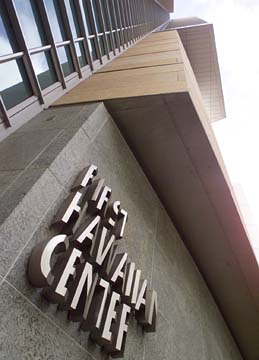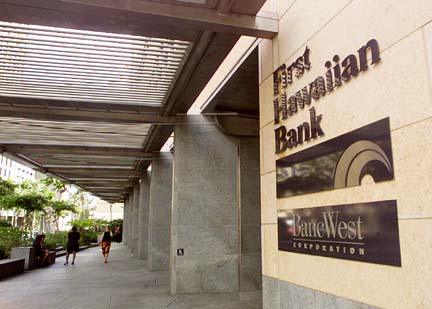


|
BancWest The $2.5 billion acquisition of First Hawaiian Bank's parent company -- the largest-ever corporate takeover in state history -- passed its final hurdle and should close Dec. 20.
deal set to
close Dec. 20
First Hawaiian customers
Bank timeline
should see little impact from
the BNP Paribas takeoverBy Rick Daysog
rdaysog@starbulletin.com
Yesterday, the Federal Reserve Board unanimously approved BNP Paribas SA's $35-a-share bid for 143-year-old First Hawaiian and its parent, BancWest Corp.
In the 5-0 vote, the Federal Reserve said the deal has "no anti-competitive effects" since BNP Paribas already controls BancWest through its 45 percent ownership in the company. BNP has owned 45 percent of BancWest and the 143-year-old First Hawaiian since November 1998.
The approval means that BNP Paribas, France's largest bank, can complete its takeover once the Fed's mandatory 15-day waiting period is up. BancWest shareholders overwhelmingly approved the buyout in September.
Bank officials stressed the transaction will have little impact on its Hawaii customers and its 2,300 local employees.

|
BancWest's stock closed up 17 cents to $34.98 today on the New York Stock Exchange.Although BancWest will become a wholly owned subsidiary of BNP Paribas, it will continue to be based in Honolulu and the names of its subsidiaries -- First Hawaiian and San Francisco-based Bank of the West -- will not change.
The company's top management team, which includes Chief Executive Officer Walter Dods Jr. and Vice Chairmen John Tsui and Howard Karr, also will remain.
"It will be business as usual," Karr said. "The only thing that changes is that we will have only one shareholder."
That may be a plus, analysts said. With the backing of $709 billion in BNP Paribas assets, BancWest can step up its aggressive growth plans.
During recent years, BancWest has expanded its West Coast operations by acquiring dozens of bank branches that were put on the market as a result of mergers between larger national banks. For instance, it acquired 23 branches in Nevada and New Mexico from Wells Fargo & Co. in 1999 when Wells Fargo merged with First Security Corp.

|
Now, it can pursue much larger deals, said Joe Morford, a banking analyst with RBC Capital Markets in San Francisco."Now that they have a bigger company and bigger balance sheet behind them they can be more opportunistic," Morford said. "My impression is that BancWest will continue to look to expand its footprint through the western United States."
The deal is the latest in a series of mega-deals to hit Hawaii this year. During the past 12 months, long-established companies such as Liberty House, Crazy Shirts and Schuler Homes Inc. have changed hands.
But for local investors, the BNP buyout will result in a financial boon.
For instance, the Estate of Samuel Mills Damon, BancWest's largest local shareholder with 15.4 million shares, stands to receive $525 million from the buyout while Alexander & Baldwin Inc., which owns about 3.3 million BancWest shares, will get about $118 million.
A look at the two companies in the deal approved yesterday: The merger
First Hawaiian Bank
Founded: 1858
Parent company: BancWest Corp.
Chief Executive: Walter Dods
Assets: $7.5 billion
Hawaii employees: 2,300
Hawaii branches: 56
BNP Paribas S.A.
Founded: 1848
Chief Executive: Michel Pebereau
Assets: $709.2 billion
Employees: 80,464
Branches: 2,200
|
Timeline of
First Hawaiian Bank
BancWest Corp., soon t o become a wholly owned subsidiary of BNP Paribas SA, a multinational banking giant based in France, traces its roots to a basement room on Kaahumanu Street.Aug. 17, 1858 >> Charles Reed Bishop, who had immigrated from upstate New York a decade earlier, and his partner, William A. Aldrich, opened Bishop & Co. -- the first successful banking partnership under the laws of the independent Kingdom of Hawaii. It operated from a basement room in "Makee & Anthon's Building" on Kaahumanu Street. Its successor, First Hawaiian Bank, today is the second oldest bank west of the Rockies. On the day Bishop & Co. opened, paying 8 percent interest on deposits, it took in $4784.25.
1878 >> Bishop & Co. outgrew its little basement room and moved to a two-story bank at the corner of Merchant and Kaahumanu Streets.
1895 >> Samuel M. Damon bought Bishop & Co. from founder Charles Bishop
Jan. 2, 1919 >> Bank, formerly a partnership, incorporated as Bank of Bishop & Co., Ltd.
Feb. 20, 1920 >> Acquired Bank of Honolulu ($1.3 million deposits). Total bank assets, $17.1 million.
Nov. 9, 1925 >> New 75,000-square-foot headquarters opened on the corner of King and Bishop Streets. By then, the bank had $22 million in assets and a half-dozen branches.
Jan. 30, 1929 >> Merger announced between Bank of Bishop and First National Bank of Hawaii, First American Savings Bank, Army National Bank of Schofield Barracks, Baldwin Bank (Maui). Name changed to Bishop First National Bank of Honolulu. Bank assets over $30 million.
1933 >> Name changed to Bishop National Bank of Hawaii at Honolulu.
1956 >> Name changed to Bishop National Bank of Hawaii. Forerunners of modern data processing installed - keypunch, card sorter, numeric accounting machine to process checks.
1960 >> Name changed to First National Bank of Hawaii. Deposit total $267 million
1962 >> Hawaii's first "skyscraper" built on the same block as Damon building. At 18 stories and 225 feet high, the $5 million building was the first downtown structure taller than Aloha Tower. It had 149,000 square feet of floor space and a 300-car garage. First National Bank of Hawaii then had assets of $340 million, 35 branches and 728 employees.
1963 >> First computer installed.
1966 >> Bank acquired Cooke Trust Company, Ltd.
1969 >> Name changed to First Hawaiian Bank, which began to market itself as "The bank that says Yes." Dan Dorman, president since 1962, became chairman of the board and 27-year-veteran John Bellinger became president.
1970 >> Deposits exceed $500 million.
March 1971 >> Introduced photo credit card. First Hawaiian Bank has the oldest photo card product in continuous production in the U.S.
1972 >> First ATMs installed.
1974 >> First Hawaiian, Inc. formed as holding company for First Hawaiian Bank with John Bellinger as president and chief executive officer.
June 1, 1975 >> Acquired former 11-branch Hawaii Thrift & Loan. It was turned into First Hawaiian Creditcorp.
1976 >> Deposits exceed $1 billion.
1977 >> Formed First Hawaiian Leasing Inc. Opened new Kapiolani branch, largest in the system.
1982 >> Deposits exceed $2 billion.
September 17, 1989 >> Chairman and CEO John Bellinger died suddenly. President Walter A. Dods Jr. named to succeed him.
May 3, 1991 >> Acquired First Interstate Bank of Hawaii.
Oct. 2, 1992 >> Acquired East West Bank.
Aug. 6, 1993 >> Acquired century-old Pioneer Federal Savings Bank.
January 9, 1994 >> The 1962 high-rise on the site of First Hawaiian Bank's headquarters was leveled to make way for the bank's new headquarters, First Hawaiian Center.
Oct. 18, 1996 >> Dedication of First Hawaiian Center, $175-million headquarters building in downtown Honolulu and Hawaii's tallest building at 428 feet, 11 inches. Gross office space: 418,000 square feet.
1995 >> Bank opened First Hawaiian Dealer Center in Irvine, Calif., handling automobile loans, its first Mainland expansion.
1996 >> First Hawaiian Bank introduces Hawaii's first PC home banking project.
May 15, 1996 >> First Hawaiian acquires 31 branches in Oregon, Washington and Idaho from U.S. Bancorp. A new subsidiary, Pacific One Bank, is created from scratch and chartered in Oregon.
July 31, 1996 >> Acquired ANB Financial Corp., owner of American National Bank in central Washington state.
April 18, 1997 >> Pioneer Federal merged into First Hawaiian Bank.
June 9, 1998 >> First Hawaiian Creditcorp merged into First Hawaiian Bank.
Nov. 1, 1998 >> Completion of merger with San-Francisco-based Bank of the West, former subsidiary of Banque Nationale de Paris (BNP) of France. The surviving company, First Hawaiian Inc., was renamed BancWest Corp. The merger was valued at nearly $1 billion, largest stock deal in history by a Hawaii company.
July 1, 1999 >> Completed $180-million acquisition of SierraWest Bancorp, parent of SierraWest Bank. The acquisition expands BancWest into Nevada for the first time.
January-February 2001 >> Completed acquisition of 30 former First Security locations with $1.2 billion in deposits and $300 million in loans.
May 7, 2001 >> Board of BancWest entered into a merger agreement to accept BNP Paribas' offer to acquire the 55 percent of BancWest stock it does not already own for $35 in cash per share. The transaction is valued at $2.5 billion.
June 1, 2001 >> First Hawaiian Bank announced agreement to acquire Union Bank of California's branch network in Guam and Saipan (3 branches, $200 million assets). The transaction is expected to close in the fourth quarter of 2001.
Dec. 4, 2001 >> Federal Reserve Board unanimously approves purchase by BNP Paribas, effectively eliminating the last hurdle.
Source: BancWest Corp.